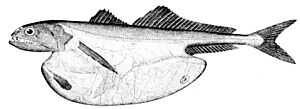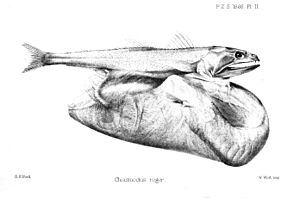Black swallower facts for kids
Quick facts for kids Black swallower |
|
|---|---|
 |
|
| Conservation status | |
| Scientific classification | |
| Synonyms | |
|
The black swallower (Chiasmodon niger) is a type of deep sea fish. It belongs to the family Chiasmodontidae. This fish is famous for its amazing ability to swallow other fish that are much bigger than itself!
You can find the black swallower all over the world. It lives in warm, tropical, and subtropical waters. It prefers the deep parts of the ocean, called the mesopelagic and bathypelagic zones. This means it lives at depths from about 700 to 2,745 meters (2,300 to 9,000 feet). It's a very common fish in the ocean, especially in the North Atlantic.
Contents
What Does the Black Swallower Look Like?
The black swallower is a small fish. It usually measures between 15 to 20 centimeters (6 to 8 inches) long. The longest one ever found was about 25 centimeters (10 inches). Its body is long and flat from side to side. It does not have any scales. Its color is a solid brownish-black.
Its head is long, and its snout (nose area) is blunt. It has medium-sized eyes and a very large mouth. The lower jaw sticks out further than the upper jaw. Both jaws have a single row of sharp teeth. These teeth can be pushed down, and they lock together when the mouth closes. The first three teeth in each jaw are larger, like fangs.
The black swallower has long pectoral fins with 12 to 14 rays. Its pelvic fins are small and have five rays. It has two dorsal fins on its back. The first dorsal fin has 10 to 12 sharp spines. The second one is longer with one spine and 26 to 29 soft rays. The anal fin on its belly also has one spine and 26 to 29 soft rays. Its tail fin is forked and has 9 rays. The lateral line (a sensory organ) runs along its body with two pores in each segment.
How Are Its Teeth Special?
The black swallower has a very unique set of teeth. It has fangs that are almost straight and point inwards. Usually, this fish has several fangs. The second fang is often the biggest.
What's really cool is that these fangs are "mobile." This means they are a bit loose in their sockets. This special feature helps the fish damage and chew its prey.
How Does the Black Swallower Eat?
The black swallower eats other bony fish and cephalopods (like squid). It swallows its prey whole. It has an amazing stomach that can stretch a lot. This allows it to swallow prey that is more than twice its own length! It can even swallow prey that is 10 times its own weight.
Its upper jaws are connected to its skull in a special way. This lets the jaws swing down and open wide. This helps the fish fit objects larger than its own head into its mouth. Scientists think the swallower grabs its prey by the tail. Then, it "walks" its jaws over the prey until the whole thing is coiled inside its stomach.
Sometimes, black swallowers swallow fish that are so big, they can't digest them fast enough. The prey starts to break down inside the swallower. This creates gases that force the swallower to float up to the ocean surface. This is actually how many black swallowers have been found by people!
For example, in 2007, a black swallower was found dead near Grand Cayman. It was about 19 centimeters (7.5 inches) long. But its stomach held a snake mackerel that was 86 centimeters (34 inches) long! That's four and a half times longer than the swallower itself.
How Does the Black Swallower Reproduce?
Black swallowers reproduce by laying eggs. This is called oviparous reproduction. Their eggs float freely in the ocean, which means they are pelagic. The eggs are small, about 1.1 to 1.3 millimeters (0.04 to 0.05 inches) wide. Each egg has a clear oil globule and six dark spots of pigment.
When the eggs hatch, these pigment spots are spread along the new larva (baby fish). They go from in front of the eyes to the tip of the notochord (a flexible rod that supports the body). As the larva grows, these spots disappear, and its body turns black. Eggs are often found in winter off South Africa. Young black swallowers (juveniles) have been found from April to August off Bermuda.
The larvae and young black swallowers are covered in tiny, spiky projections called spinules.



